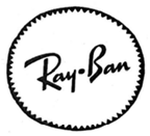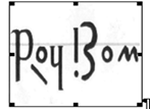
1. Hechos.
La compañía Luxotica Group SpA es titular de una marca de la UE y dos marcas españolas sobre el distintivo RAY-BAN, en clase 9, que cubren las siguientes representaciones:



El demandado es titular de un registro español de marca, en clase 9, que cubre la siguiente representación:

Si volteamos el anterior distintivo, el signo que se obtiene se aproxima a las marcas de Luxotica Group SpA:

Además, el demandado utiliza su marca en el mercado del siguiente modo:

Por ello, Luxotica Group SpA interpuso (i) una acción de nulidad absoluta contra el registro de marca del demandado por haber mediado mala fe en el momento de la solicitud; (ii) subsidiariamente, una acción de nulidad relativa por incompatibilidad de dicho registro con sus marcas notorias RAY-BAN; (iii) una acción de infracción basada en la existencia de riesgo de confusión y en la protección especial de las marcas notorias.
La acción fue íntegramente estimada en primera instancia.
2. Pronunciamientos.
Primero, la Audiencia examina el recurso de apelación formulado por el apelante/demandado que se dirige, en primer lugar, contra la declaración de nulidad de su marca en base a la mala fe.
Refiriéndose a su sentencia nº 396/12 (ECLI:ES:APA:2012:3010) de 27 de septiembre, la Audiencia enumera los criterios que permiten apreciar la concurrencia de mala fe. Seguidamente, el tribunal concluye que, a la luz de dichos criterios, debe concluirse que en el presente caso concurría mala fe en el momento de la solicitud de la marca impugnada en la medida en que:
- Aun cuando la marca registrada es aparentemente distinta a las marcas anteriores, al voltearla descubrimos un signo que presenta un elevado grado de similitud con aquellas.
- Para conseguir lo anterior, el apelante utiliza signos de fantasía que impiden que pueda detectarse la posible confusión con otras marcas prioritarias en la fase de oposición;
- Las marcas de la actora son notorias y, por tanto, el hecho de que el apelante las conociera revela su conducta parasitaria contraria a la buena fe; y
- Personas cercanas al apelante (residentes en el mismo domicilio) habían intentado –sin éxito- solicitar marcas similares.
En segundo lugar, la Audiencia examina la alegación del recurso formulado por el demandado en relación con la supuesta incongruencia del pronunciamiento relativo a la indemnización por daños y perjuicios.
En este punto, el Tribunal dictamina que aun cuando la sentencia de instancia no examinaba los presupuestos de la acción por infracción, debe entenderse su estimación implícita en la medida en que los elementos estructurales de la acción de nulidad relativa –que si se examinaban- son extrapolables a la misma por concurrir riesgo de confusión.
En relación con la acción de infracción, la Audiencia confirma el acogimiento de la doctrina sentada por el TJ (sentencia de 21 de febrero de 2013, asunto C-561/11) en relación con la posibilidad de ejercitar la acción de violación frente a un tercero titular de una marca posterior y tras ello concluye que la concurrencia en el caso de riesgo de confusión no deja lugar a dudas, por lo que procedía la estimación de la acción de violación.
Por último, la Audiencia hace referencia a la impugnación de la sentencia por parte de la actora en relación con las bases fijadas en la sentencia de instancia para cuantificar la indemnización y concluye que la sentencia de instancia contiene varias incorrecciones.
Así las cosas, la Audiencia acuerda la modificación del pronunciamiento contenido en la sentencia de instancia relativo a la cuantificación de la indemnización que, conforme a lo solicitado por la actora, queda fijada en 101.857 Euros.
3. Comentario.
La propia naturaleza de la marca solicitada/impugnada –el modo en que esta se representa- puede ser también un factor relevante a la hora de apreciar la mala fe del solicitante en el momento de la solicitud
(Fuente de la información: ANUARIO ELZABURU 2016, recopilatorio de comentarios de jurisprudencia europea en materia de Derecho de Propiedad Industrial e Intelectual que realiza Elzaburu).
Documento citado:
- SAP Alicante de 27 septiembre 2012
- STribunal de Justicia (UE) Sala 1ª de 21 febrero de 2013
ENGLISH VERSION
Invalidity of trademarks applied for in bad faith. Judgment of the European Union Trademark Court of 15 July 2016, Ray-Ban (ECLI:ES:APA:2016:1969).
1. Background.
Luxotica Group SpA is the holder of an EU trademark and two Spanish trademarks for RAY-BAN in Class 9. The graphic representations of those marks are shown below:



The defendant is the holder of a Spanish trademark registration, in Class 9, with the following graphic representation:

If we rotate that mark, the resulting sign bears a resemblance to Luxotica Group SpA’s trademarks:

Moreover, the defendant is using its mark in the following manner in trade:

In those circumstances, Luxotica Group SpA filed: (i) an invalidity action on absolute grounds against the defendant’s trademark, based on the argument that it had been applied for in bad faith; (ii) in the alternative, an invalidity action on relative grounds due to that registration’s confusing similarity to its well-known RAY-BAN trademarks; and (iii) an action for infringement based on the existence of a likelihood of confusion and on the special protection granted to well-known trademarks.
The action was accepted in full at first instance.
2. Findings.
The appeal court first of all examines the appeal lodged by the appellant/defendant against the declaration of invalidity of its trademark based on bad faith.
Referring to its judgment no. 396/12 (ECLI:ES:APA:2012:3010) of 27 September, the appeal court lists the criteria to be followed in order to establish bad faith. It concludes that, in light of those criteria, the contested mark had been applied for in bad faith insofar as:
- Even though the registered trademark would appear to differ from the earlier trademarks, when it is rotated, we are left with a sign that displays a high degree of similarity to those marks;
- In order to achieve this, the appellant uses fanciful signs that prevent potential confusion with earlier trademarks from being detected during the opposition phase;
- The plaintiff’s trademarks are well known, and therefore, the fact that the appellant was aware of them reveals its parasitic conduct, contrary to the rules of good faith; and
- Persons close to the appellant (residents at the same address) had tried to apply for similar trademarks to no avail.
The appeal court then examines the defendant’s ground for appeal relating to an alleged incongruity in respect of the finding on damages.
In this regard, the court finds that even though the lower court did not examine the premises for the infringement action, acceptance of that action should be deemed implicit insofar as the structural elements of the invalidity action on relative grounds –which were examined- can be extrapolated to it due to the fact that there is a likelihood of confusion.
With respect to the infringement action, the appeal court confirms the doctrine established by the ECJ (judgment of 21 February 2013, case C-561/11) regarding the possibility of bringing proceedings for infringement against a third-party proprietor of a later trademark, and thus concludes that since there is no doubt as to the likelihood of confusion in this case, the infringement action should be accepted.
Lastly, the appeal court refers to the plaintiff’s opposition regarding the bases for assessing damages established in the lower court’s judgment, and concludes that the judgment contained several errors.
The appeal court therefore ordered the amendment of the lower court’s finding concerning the assessment of damages which, as requested by the plaintiff, were fixed at 101,857 Euros.
3. Remarks.
The very nature of the trademark application at issue, i.e., the way in which it is represented, can also be a relevant factor when assessing whether it had been filed in bad faith.
ElDerecho.com no comparte necesariamente ni se responsabiliza de las opiniones expresadas por los autores o colaboradores de esta publicación








